The HEDP Group studies all aspects of x-pinches, z-pinches and wire arrays driven by compact pulsed power devices. These experiments are of interest as highly dynamic plasma objects, high flux compact x-ray sources, and also in their application to Inertial Confinement Fusion (ICF) and Inertial Fusion Energy (IFE).
The study of wire ablation in these configurations is a subject of particular interest to the research community, because of its strong effect on the evolution of plasma structure. Scaling of the ablation process with drive current and materials will determine the confidence in very high current (>60MA) driver designs for ICF. The HEDP group designs and conducts experiments to dissect specific areas of the ablation process. These are carried out on an 80kA marx driven pulser, and the 250kA GenASIS linear transformer driver (LTD). The data from these studies enables us to more fully understand the fundamental properties of ablated plasma structures and determine the physical mechanisms driving their behaviour.
Supersonic jet formation has also been studied extensively in its application to astro-physical phenomenon and interaction with interstellar medium and other objects. High velocity outflows are in several classes of object, particularly in the development of stars (Young Stellar Objects, or YSOs). Direct measurement of these objects' properties is often difficult to recover, given the vast distances and timescales involved, so the ability to generate scaleable plasma outflows in the lab is a highly valuable tool for developing astro-physical models of celestial body development. Both x-pinches and wire arrays have been studied in this relatively new field of High Energy Density Laboratory Astrophysics and have been shown to scale at high Mach number outflows, such as Herbig-Haro (HH) objects.
Pulsed Power Drivers
There are currently two compact, high current pulsed power generators in the HEDP group laboratory. The first produces a maximum current of 80 kA with a zero-to-peak rise-time of 50ns, and the second producing a 250 kA peak current over 150ns. These devices can be charged and fired several times per day, and are operated and maintained by the research staff and students.
X-Pinch Pulser
The X-Pinch pulser is a Marx bank driven system which produces 80 kA
with a risetime of 50ns. The Marx bank comprises 4 x 0.1 micro-Farad
capacitors which are charged to 50kV, giving a stored energy of
about 1 kJ. This discharges into a water filled 1.5 ohm
Pulse-Forming Line (PFL) with a single transit time of 26ns which
compresses the voltage pulse. This is then delivered into the load
region via a self-breaking sulphur hexaflouride (SF6) switch.
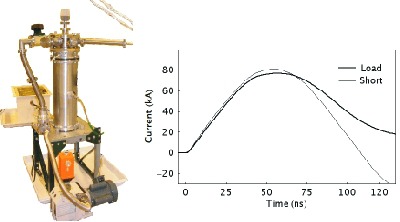
Gen-ASIS: Generator for Ablation Structure and Implosion Studies
GenASIS is compact pulser based on the Linear Transformer Driver
design, which represents the new generation of modular pulsed power
units likely to be used in ICF ignition and IFE designs.
The UCSD machine, installed in collaboration with Sandia National Laboratories, comprises 12 x 20 nF capacitors charged in parallel to 75 kV. A small marx unit triggers the main discharge by closing 4 low inductance multi-channel switchblocks. The current is delivered to the load via a coaxial conical power feed designed to maintain a low inductance (~7nH) and optimise energy delivery. Measured load currents are 250kA into a short curcuit load and 210kA into a wire array load. For a complete description of GenASIS, please click here.
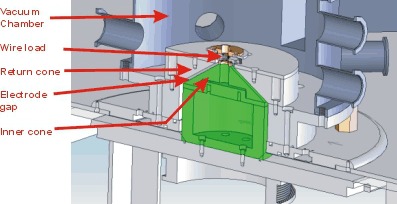
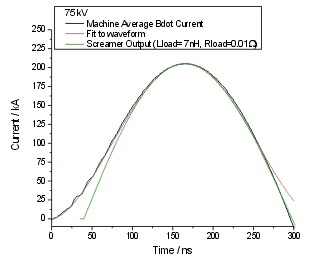

X-Pinches
An X-pinch is a target configuration used in pulsed-power to create high-intensity, fast, and point-like X-ray sources; the emission duration is typically a few nanoseconds and the spatial dimension a few microns. Traditionally, X-pinches are made from two or more wires made to touch at a single point forming the shape of an X. When a rapidly rising current is applied to the wires of the X-pinch, they explode and become plasma. A force referred to as the J x B force constricts the plasma at the point where the wires cross, creating an area of higher temperature and density that eventually emits X-rays. Uses for the X-pinch include radiography, lithography, and studying plasma at high temperature and density.
While a powerful diagnostic tool, the X-pinch lacks repeatability in various parameters such as source size, timing, flux, number of sources, and source location, making their use in high-cost, low-shot-count experiments and their integration with other systems infeasible. One potential source of variability is the somewhat arbitrary condition of `touching' wires at the crosspoint.
With the help of General Atomics' Laser Micro-Machining (LMM) center we have cut X-pinches from metal foil to determine if we can improve the reliability of the X-ray source the X-pinch makes. Using the 250 kA, 150 ns rise-time GenASIS Linear Transformer Driver (LTD), we have compared foil X-pinches to wire X-pinches of similar mass at the crosspoint (within 10%). Foil X-pinches show an increase in X-ray flux and improved reliability in the pulse timing, pulse duration, source size, and source location. The information from these experiments may lead to a more reproducible and customizable X-ray source, and also help us better understand exactly the physics of what goes on at the center of an X-pinch when it emits X-rays.
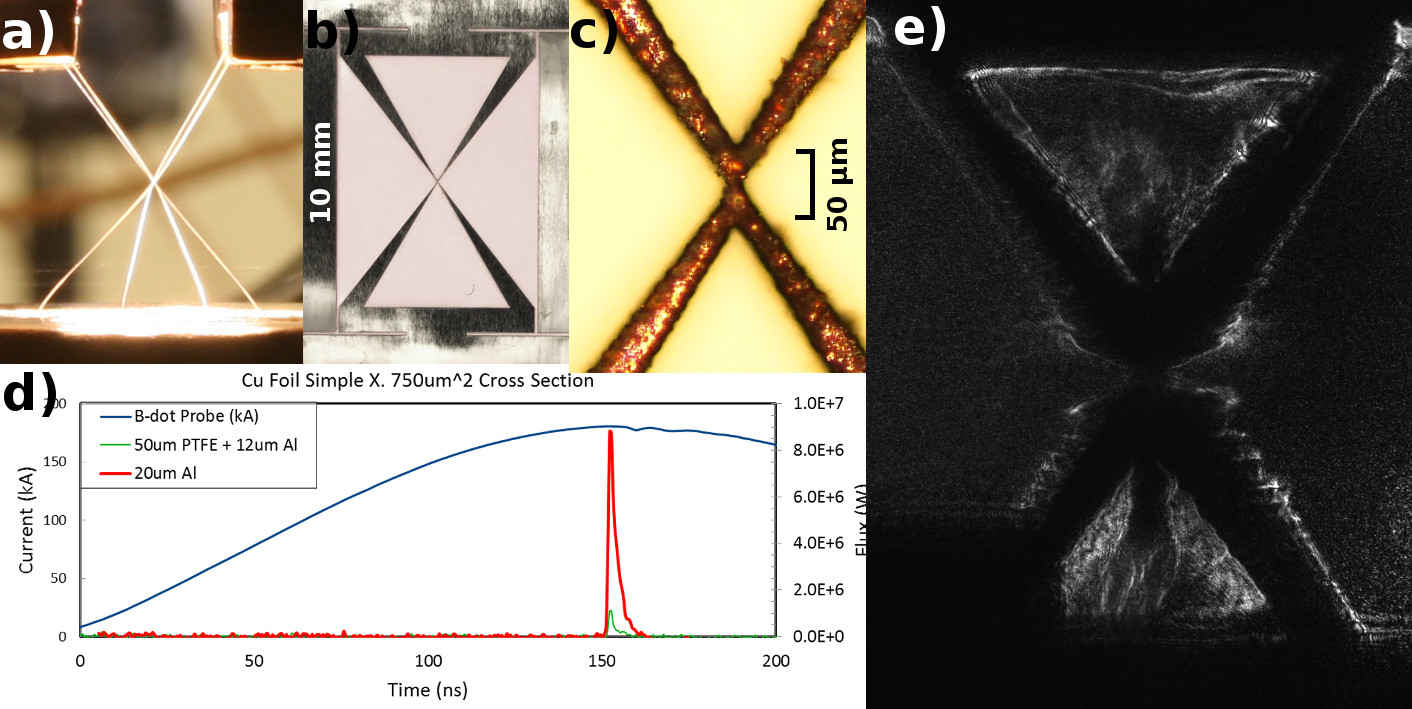
a) A typical wire X-pinch
b) A newly machined Tantalum foil X-pinch
c) A 20X magnified copper foil X-pinch
d) The current and X-ray signals from a copper foil X-pinch
e) Schlieren image of a copper foil X-pinch (at 105.5 ns after current start)
z-pinches
Wire Array Z-Pinches
Wire array z-pinches comprise a cylindrical arrangement of metal
wires (typically Al or W) driven by a fast-rising current drive.
Wire diameters are typically 5 to 50 microns in diameter and are
strung between two electrodes. On smaller generators, arrays can
use as few 8 wires, and larger generators can use several hundred.
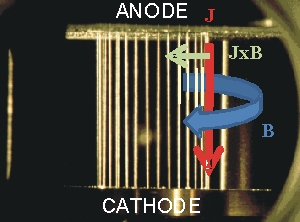 For most experiments the drive current is 100 kA to several MA
and rises to a maximum in around 100ns. This axial current
creates an azimuthal magnetic field which causes the array to
collpase onto its axis, creating a high power soft x-ray burst.
The largest pulsed power generator in the world is based at
Sandia National Laboratories, and produces 1.8 MJ of x-ray
energy at a power of 280 TW, and is a potential driver for both
Inertial Confinement Fusion (ICF) and Inertial Fusion Energy
(IFE) [1]. This has recently been refurbished to provide a peak
current of 26 MA.
For most experiments the drive current is 100 kA to several MA
and rises to a maximum in around 100ns. This axial current
creates an azimuthal magnetic field which causes the array to
collpase onto its axis, creating a high power soft x-ray burst.
The largest pulsed power generator in the world is based at
Sandia National Laboratories, and produces 1.8 MJ of x-ray
energy at a power of 280 TW, and is a potential driver for both
Inertial Confinement Fusion (ICF) and Inertial Fusion Energy
(IFE) [1]. This has recently been refurbished to provide a peak
current of 26 MA.
Wire array z-pinches are a complex plasma system, and produce
a wide range of plasma parameters throughout their evolution.
The experiment can typically be broken down into 4 identifiable
stages:
1) Wire inititation
2) Ablation phase
3) Implosion phase
4) Stagnation and x-ray generation
The high voltage from the pulsed power generator (100kV to
several MV) initiates the array by rapidly causing electrical
breakdown at the wire surface, forming a plasma in a few
nanoseconds. At this point each wire forms an heterogeneous
plamsma structure referred to as the core-corona model. A cold
dense wire core is surrounded by a hot low density coronal
plasma. Due to the greater volume and higher ionisation (an
hence conductivity) of the corona, it is this plasma which
carried much of the current and hence is accelerated towards
the array axis. During the ablation phase, which can last for
up to 80% of the experiment, the cores remain stationary and
replenish the coronal material as it is removed by the Lorentz
force [2].The rate at which mass is ablated from the wires
typically scales as I2 [3], and this determines the density of
both the ablated plasma streams and subsequent structures formed
interior to the array as these ‘jets’ converge onto the array
axis [4, 5].
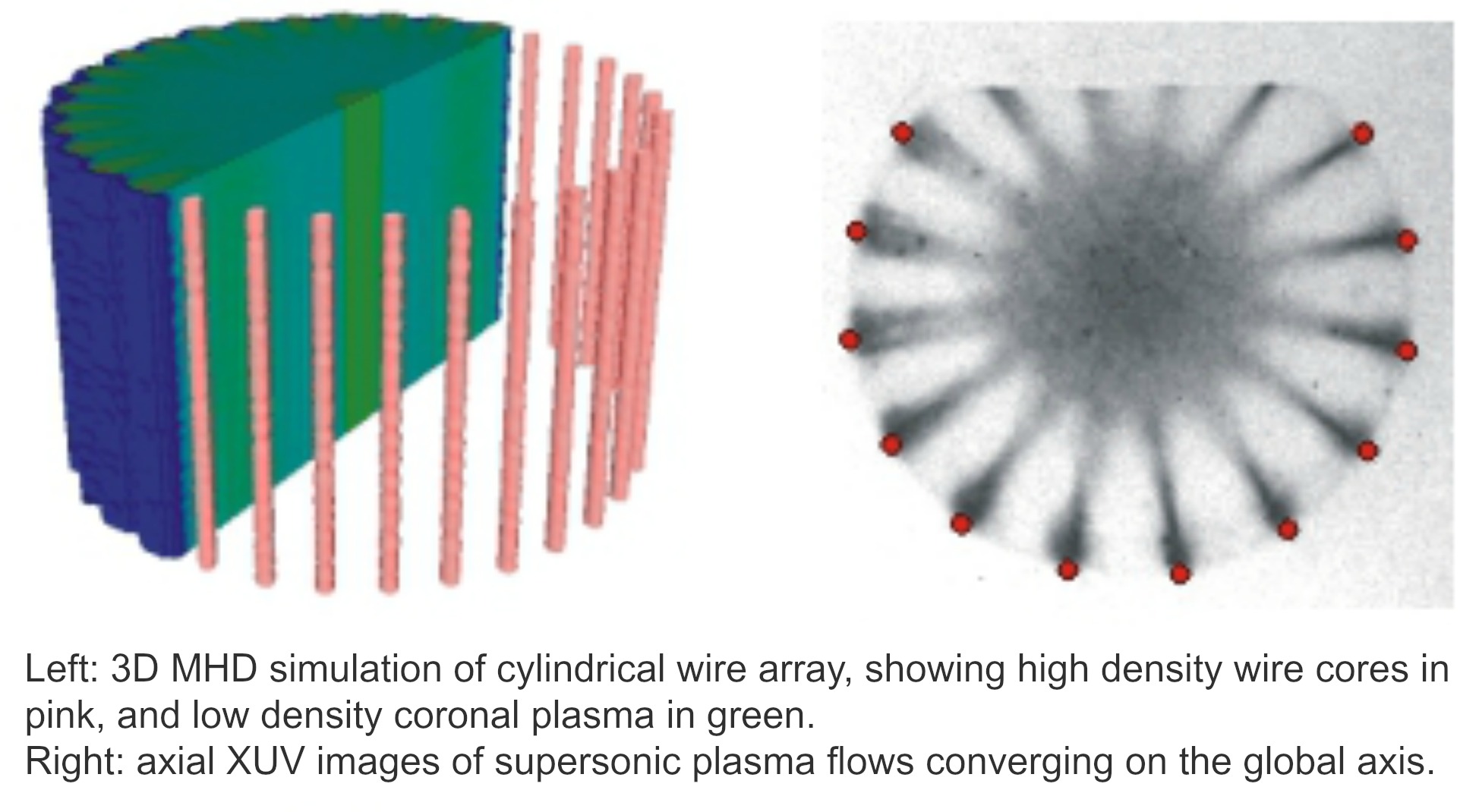
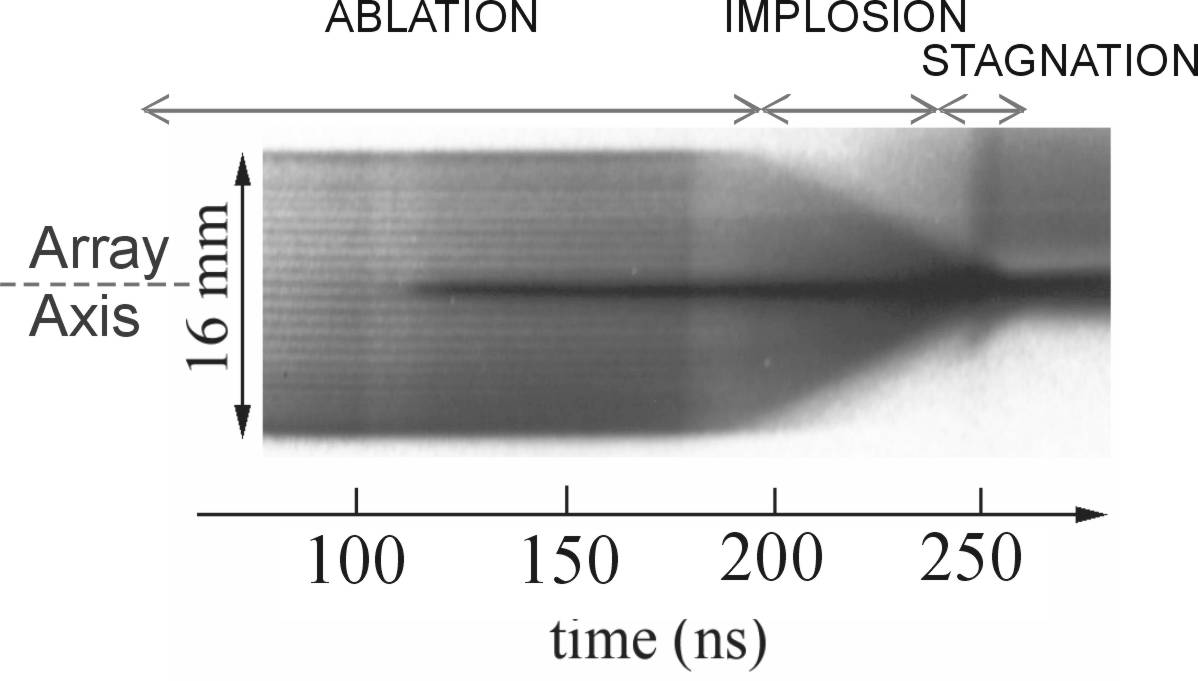 The stream densities produced in experiments have ion
densities in the range of 1x1014 – 5x1017 cm-3, typically with
temperatures 5-15eV and Mach numbers between 3 and 5. Streams
at current of 1 MA are typically collisional on the order of the
array diameter (~8 mm), and form shock structures observable in
emission images around objects place in their path, such as
occurs in nested wire array experiments [5].
The stream densities produced in experiments have ion
densities in the range of 1x1014 – 5x1017 cm-3, typically with
temperatures 5-15eV and Mach numbers between 3 and 5. Streams
at current of 1 MA are typically collisional on the order of the
array diameter (~8 mm), and form shock structures observable in
emission images around objects place in their path, such as
occurs in nested wire array experiments [5].
Eventually enough mass has been ablated from the wires that they begin to break, and this triggers the implosion phase. The JxB force accelerates much of the array mass towards the axis at velocities of 300 km s-1, as can be deduced from the change in array diameter observed on radial streak camera images.
The magnetic piston snow ploughs up the pre-fill plasma which serves to stabilize the implosion surface. The stagnation of this mass at the array axis converts kinetic energy into thermal energy and this, along with additional heating from the plasma compression by the magnetic field, is radiated as a short (less than 10ns) high power x-ray pulse. A time slice at stagnation form a 3D Magneto-Hydrodynamic simulation using the GORGON code [7], and example x-ray data is given below from the Z machine at Sandia National Laboratories (Ref [1])
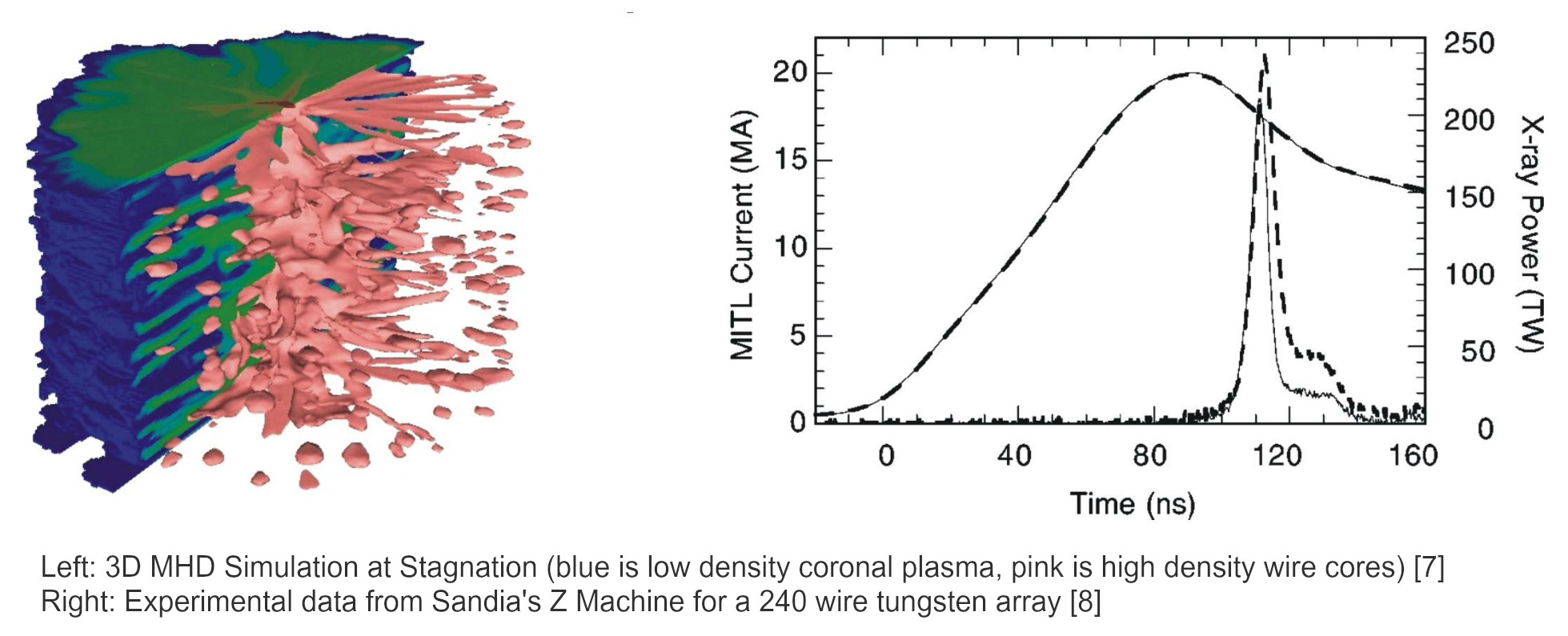 [1] M.E. Cuneo et al, Plasma Phys Control. Fusion, 48, R1 (2006)
[1] M.E. Cuneo et al, Plasma Phys Control. Fusion, 48, R1 (2006)
[2] S.V.Lebedev et al, Phys. Plasmas, 6, 2016, (1999)
[3] S. Lebedev et al, Phys. Plasmas, 8, 3734, (2001)
[4] S.C.Bott et al, Phys Rev E, 74, 046403 (2006)
[5] S.C.Bott et al, IEEE Trans. Plasma Sci, 35, 165 (2007)
[6] D.J.Ampleford et al, Phys. Rev Lett., to be submitted
[7] J.P.Chittenden et al, Plasma Phys Control. Fusion, 46, B457 (2004)
[8] R.B.Spielman et al, Phys. Plasmas, 5, 2105, (1998)
Injector Design for Staged Z-Pinch
Nuclear fusion is a potential solution to mankind’s energy needs, as
it may provide a near-endless energy supply. Unfortunately, nuclear
fusion for civilian applications is still in the research phase and
many problems have yet to be solved, first of all what is the best
configuration to efficiently induce the fusion of light atomic
nuclei. A Z-pinch is one of the earliest approaches used to study
thermonuclear fusion, due to its relatively simple system to
compress the plasma: during a pulsed-power discharge in a
cylindrical plasma, the self-generated magnetic field is used to
compress the plasma by the JxB force.
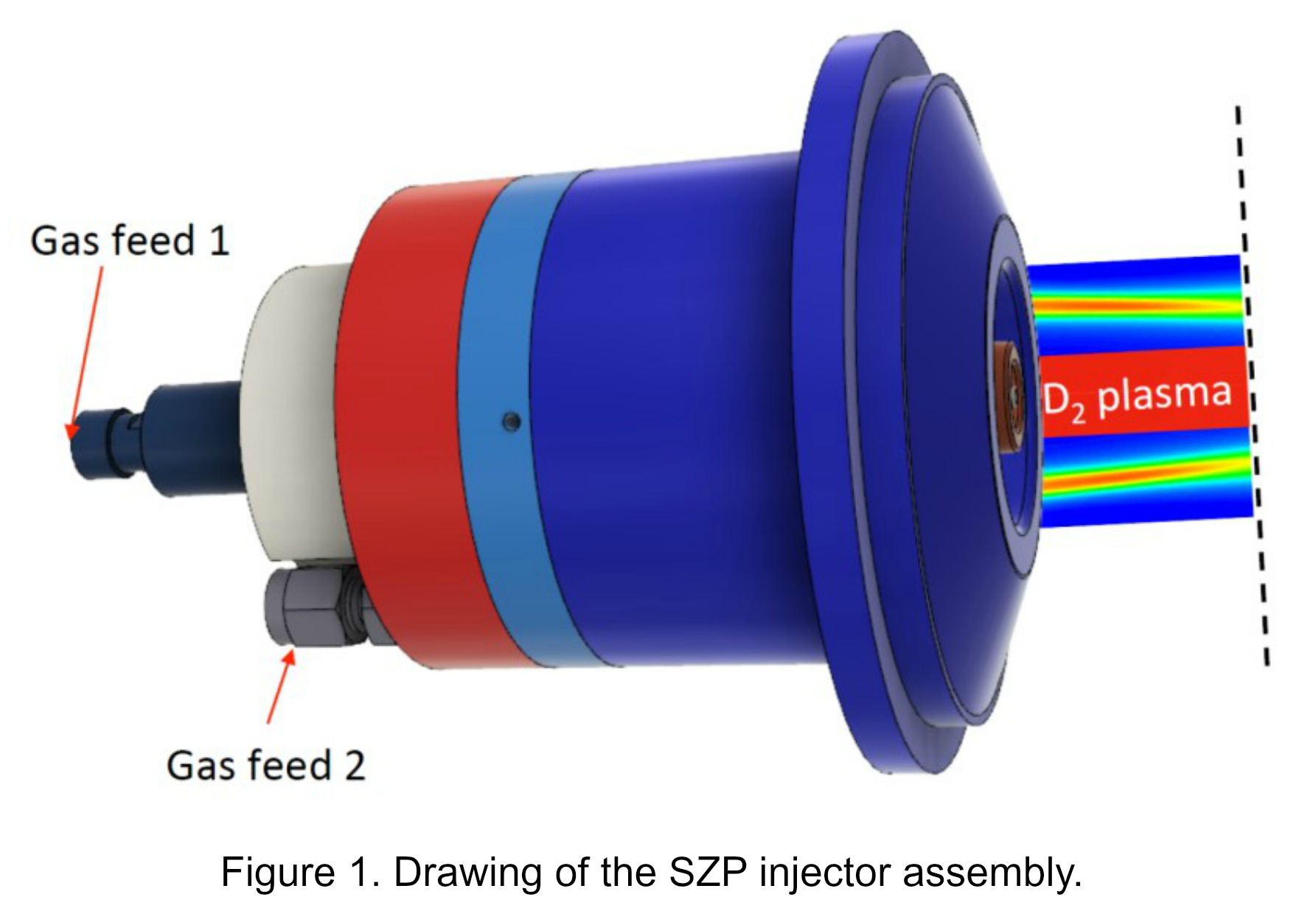 The study of Z-pinches has remained an active area of
interest, mainly thanks to the high yield of nuclear events
produced by this configuration, for example in the production
of X-rays and neutrons. Although the Z-pinch provides a
mechanism for the direct conversion of electrical energy into
thermal energy of the plasma, energy coupling is often not very
effective mainly because of the unstable nature of the imploding
plasma column.
The study of Z-pinches has remained an active area of
interest, mainly thanks to the high yield of nuclear events
produced by this configuration, for example in the production
of X-rays and neutrons. Although the Z-pinch provides a
mechanism for the direct conversion of electrical energy into
thermal energy of the plasma, energy coupling is often not very
effective mainly because of the unstable nature of the imploding
plasma column.
A Staged Z-pinch is a particular Z-pinch configuration comprised of a high-atomic-number liner, imploding onto a coaxial, lower-atomic-number plasma target. When the outer liner implodes, it scoops in the inner target towards the axis. This “staging” process, where the implosion energy is transferred from one material to another, suppresses the fluid instabilities that may arise and is expected to produce a faster, greater compression to favorable thermonuclear fusion conditions.
 The HEDP group is working to design and characterize a plasma
injector to provide optimal initial conditions to launch a
staged Z-pinch.
The HEDP group is working to design and characterize a plasma
injector to provide optimal initial conditions to launch a
staged Z-pinch.
The injector produces an annular, high-atomic-number, neutral gas puff co-axially with a target Deuterium plasma.
The neutral gas-puff is produced by an annular solenoid valve and a converging-diverging nozzle , designed to achieve a Mach number around M=5 in the annular gas jet. The on-axis, cylindrical plasma is produced by a coaxial plasma gun, powered by a high voltage capacitor bank which is discharged at the optimal time after the Deuterium gas has been injected.
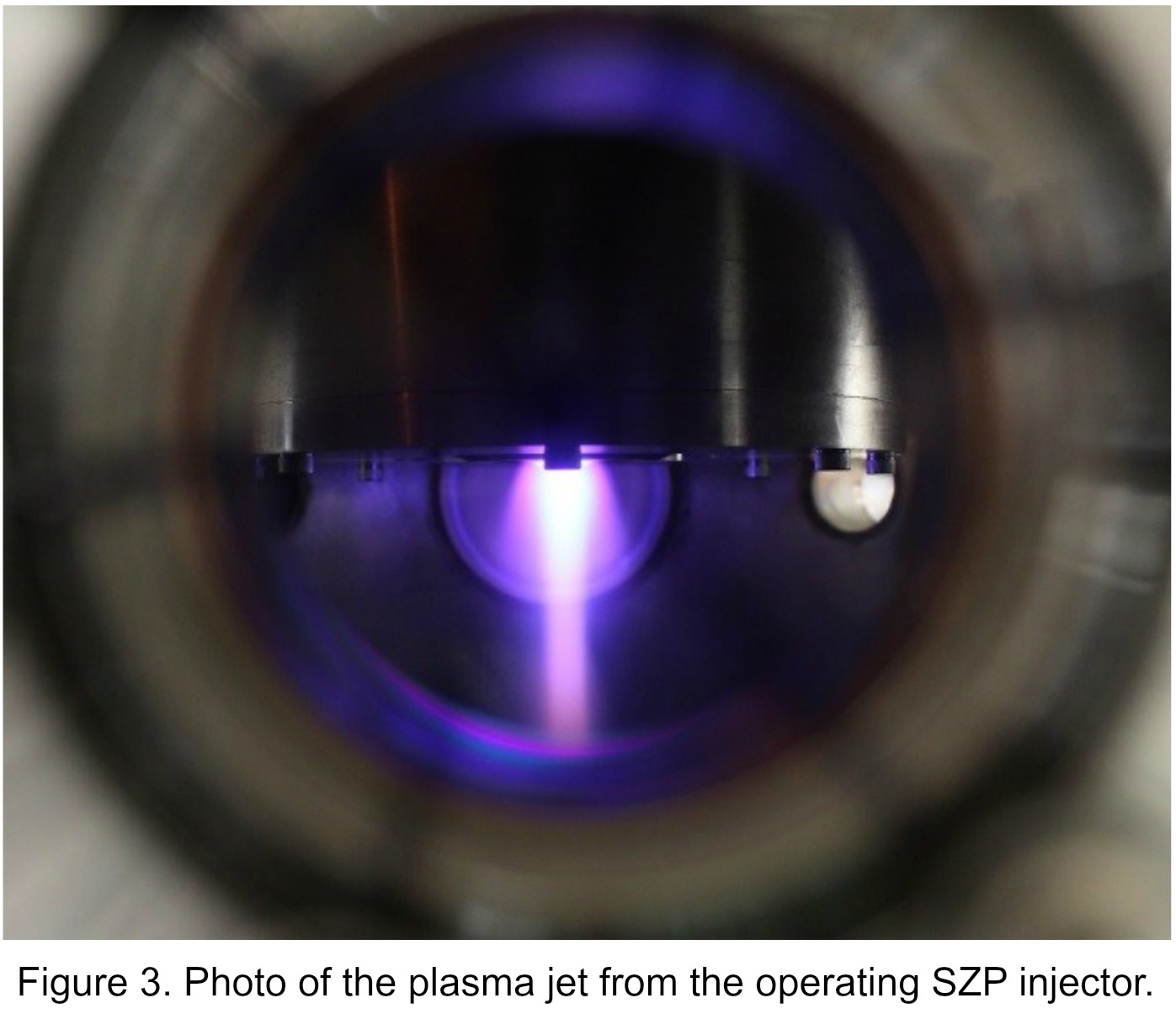 In order to achieve an optimal implosion, the annular gas and
the target plasma must have precisely tuned mass density
profiles. The injector design is optimized with the CFD
simulation code, Fluent, and using CAD software, while the
machining is performed at the UCSD machine shop.
In order to achieve an optimal implosion, the annular gas and
the target plasma must have precisely tuned mass density
profiles. The injector design is optimized with the CFD
simulation code, Fluent, and using CAD software, while the
machining is performed at the UCSD machine shop.
After design and construction, the nozzle is characterized with optical diagnostics such as laser interferometry, measurement of the visible light emission etc, and electrical diagnostics such as breakdown pin and Faraday cup measurements to determine the properties of the mass flow.
Mach2 Simulations of the Implosion in a Staged Z-Pinch
The Staged Z-pinch is a promising method for creating
high-energy-density plasmas in the regimes necessary for fusion energy
production. As in the standard Z-pinch, a cylindrical plasma shell
(liner) is compressed in response to a self-generated JxB force. Inside
the shell is a low-Z target, typically deuterium. As the magnetic
pressure increases in the liner, a shock front forms, detaching and
compressing the target ahead of the slow-moving liner. This shock front
preheats the target, reducing the compression ratio necessary for
reaching ~10 keV temperatures at peak implosion.
 In recent simulations, we have used the single-fluid,
resistive MHD code MACH2 to study the shock formation in
theoretical gas puff experiments using the Zebra generator,
which delivers ~1 MA to the load with a rise time of ~140 ns.
Four gases were used as liners: Ne, Ar, Kr, and Xe with
initially Gaussian profiles of width 0.3 cm (FWHM 0.15 cm) and
peak density 4.0 x 10-5 g/cm3. The target was a uniform fill of
DD of density 5.0 x 10-7 g/cm3. A 0.1% perturbation was
implemented in 2D runs to seed instability growth. Our results
predict the formation of shock fronts that preheat the target in
all four materials, delaying the onset of instability formation
inside the target. A thorough understanding of the shock
formation and development, provided proper benchmarking with
experimental results, could allow us the ability to tailor
initial conditions and current profiles to achieve optimal
implosion dynamics.
In recent simulations, we have used the single-fluid,
resistive MHD code MACH2 to study the shock formation in
theoretical gas puff experiments using the Zebra generator,
which delivers ~1 MA to the load with a rise time of ~140 ns.
Four gases were used as liners: Ne, Ar, Kr, and Xe with
initially Gaussian profiles of width 0.3 cm (FWHM 0.15 cm) and
peak density 4.0 x 10-5 g/cm3. The target was a uniform fill of
DD of density 5.0 x 10-7 g/cm3. A 0.1% perturbation was
implemented in 2D runs to seed instability growth. Our results
predict the formation of shock fronts that preheat the target in
all four materials, delaying the onset of instability formation
inside the target. A thorough understanding of the shock
formation and development, provided proper benchmarking with
experimental results, could allow us the ability to tailor
initial conditions and current profiles to achieve optimal
implosion dynamics.
Laboratory Astrophysics
Wire array z-pinches provide a very flexible plasma generation
system and are increasingly used to address astrophysical plasma
physics problems. It is possible to create systems analogous to
those observed in the universe, and this enables an investigation
of theoretical predictions of the behaviour of astrophysical objects
in a controlled, highly diagnosed laboratory environment. A brief
overview is given below, and a summary of the present capabilities
of pulsed power driven wire array in laboratory astrophysics can be
found here.
 Simple modifications of the standard cylindrical wire array can
be applied to produce dense, highly supersonic plasma jets. In a
conical wire arrays the wires are inclined to the axis producing
an opening angle typically of ~30 degrees. The ablated plasma is
accelerated perpendicular to the wires and collides on axis,
where the radial velocity is cancelled by opposing streams but
the axial velocity is maintained. This process produces
hydrodynamic jets with velocities ~200 km/s at M > 20 with
densities ~10^19 cm-3. These jets are designed to experimentally
simulate astrophysical outflows such as Herbig-Haro objects
(e.g. HH47) associated with newly forming stars (YSOs), and have
been shown to scale to astrophysical systems via dimensionless
parameters [1].
Simple modifications of the standard cylindrical wire array can
be applied to produce dense, highly supersonic plasma jets. In a
conical wire arrays the wires are inclined to the axis producing
an opening angle typically of ~30 degrees. The ablated plasma is
accelerated perpendicular to the wires and collides on axis,
where the radial velocity is cancelled by opposing streams but
the axial velocity is maintained. This process produces
hydrodynamic jets with velocities ~200 km/s at M > 20 with
densities ~10^19 cm-3. These jets are designed to experimentally
simulate astrophysical outflows such as Herbig-Haro objects
(e.g. HH47) associated with newly forming stars (YSOs), and have
been shown to scale to astrophysical systems via dimensionless
parameters [1].
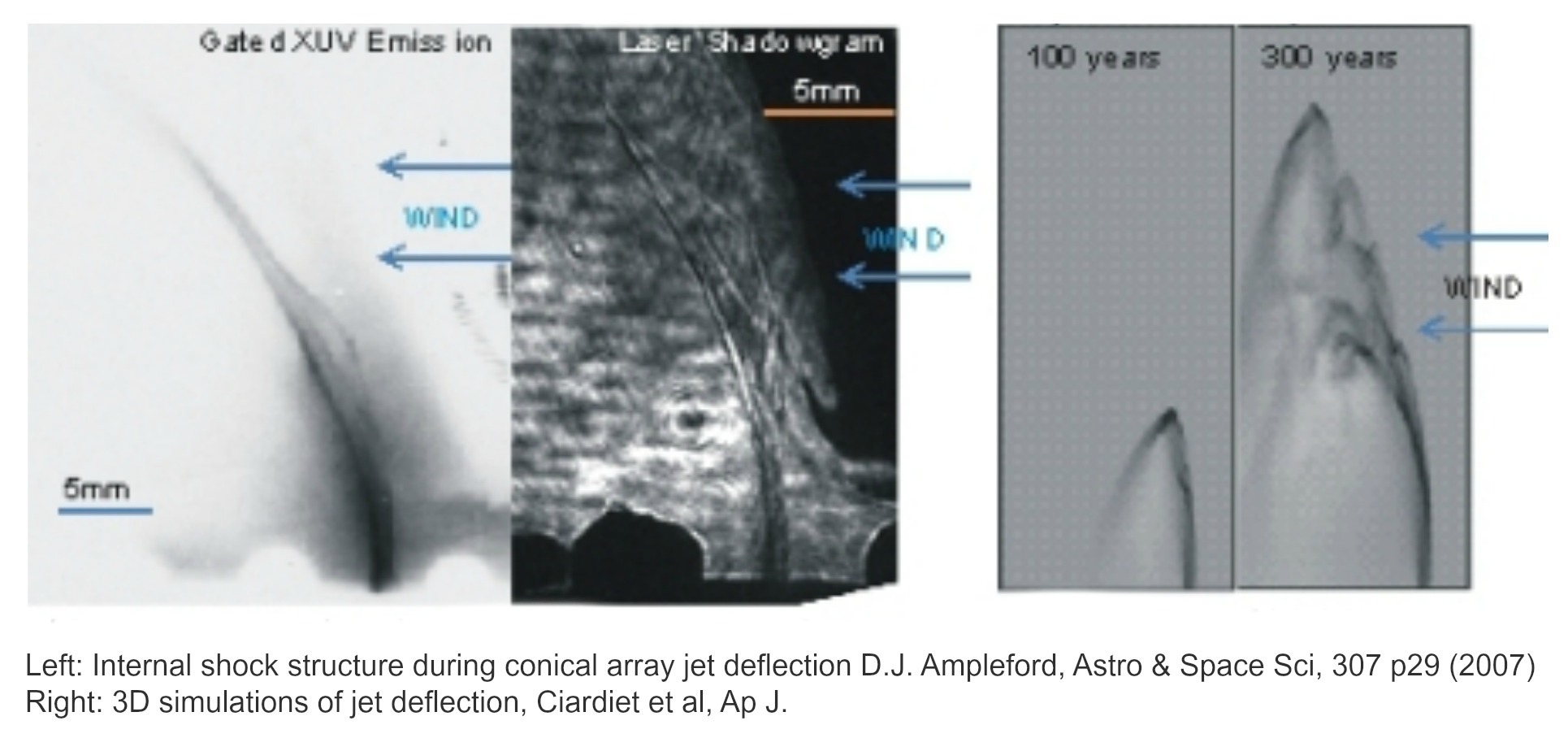 The long propgation distances of these jets (>20mm) and long
lifetimes (>200ns) allows a range of interaction experiments to
be performed in an attempt to simulate the bending observed in
astrophysical jets due to either a moving course or collisons
with other objects (e.g. nebulae). In the laboratory, a plasma
cross-wind is created by photoablation of a CH foil located
above the wire array which expands across the jet propagation
direction. The jets are observed to be deflected on interaction
with the plasma cross wind, but maintain thier collimation and
develop extensive internal shock struture [2,3].
The long propgation distances of these jets (>20mm) and long
lifetimes (>200ns) allows a range of interaction experiments to
be performed in an attempt to simulate the bending observed in
astrophysical jets due to either a moving course or collisons
with other objects (e.g. nebulae). In the laboratory, a plasma
cross-wind is created by photoablation of a CH foil located
above the wire array which expands across the jet propagation
direction. The jets are observed to be deflected on interaction
with the plasma cross wind, but maintain thier collimation and
develop extensive internal shock struture [2,3].
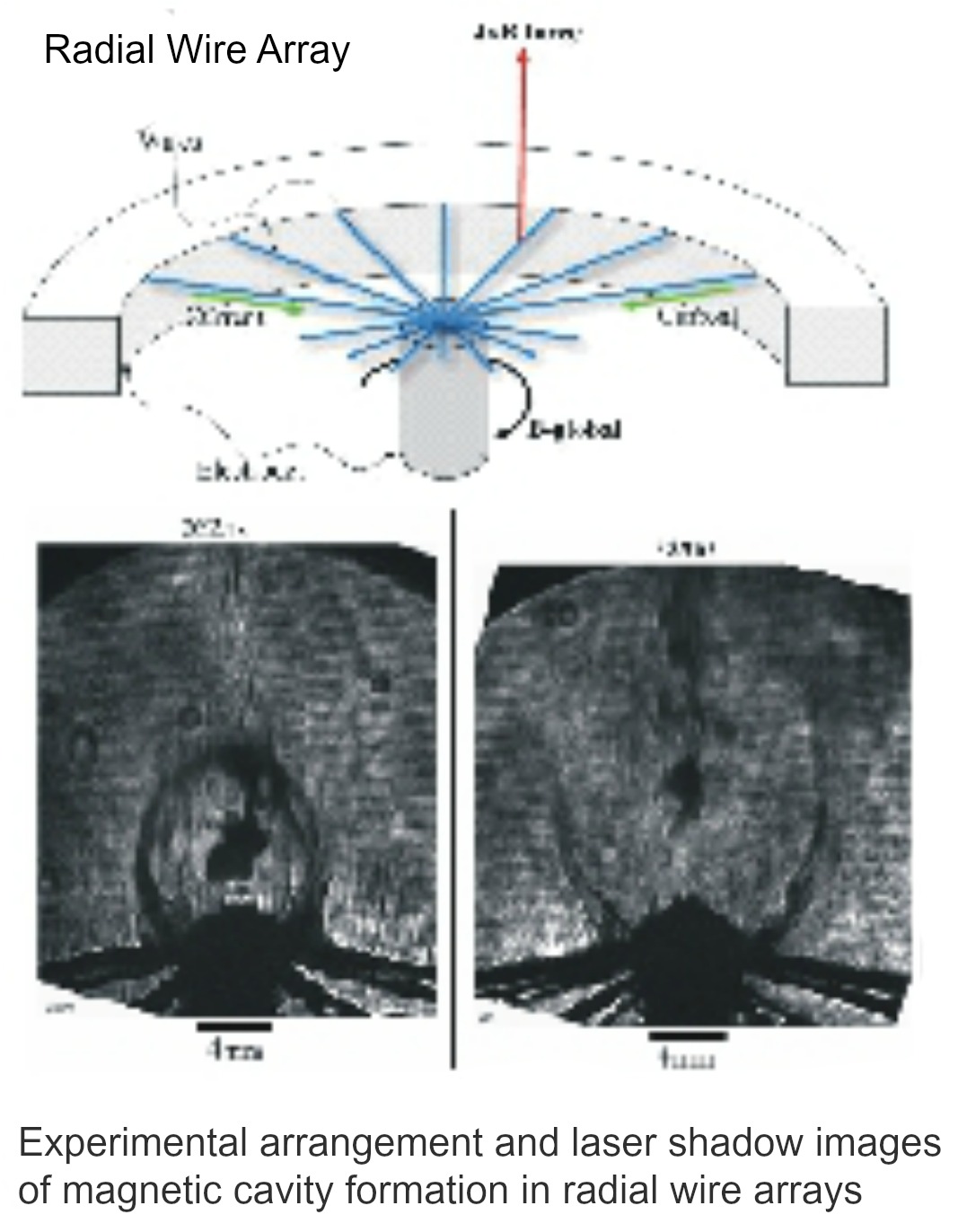 Such jets are also produced in x-pinch configurations at
currents as low as 80 kA, and this has been demonstrated using a
compact Marx pulser at UCSD [5]. 3D Simulations of these jets,
benchmarked against the experimental data, can be used to infer
the magnatic Reynolds number of the outflow, and also to examine
the interaction of the jet with a background gas fill.
Such jets are also produced in x-pinch configurations at
currents as low as 80 kA, and this has been demonstrated using a
compact Marx pulser at UCSD [5]. 3D Simulations of these jets,
benchmarked against the experimental data, can be used to infer
the magnatic Reynolds number of the outflow, and also to examine
the interaction of the jet with a background gas fill.
In addition to hydrodynamic jets, a different system can be use to magnetically launch jets from wire arrays. A radial wire array comprises wires strung from a central electrode to a concentric return path in a 'wheel spoke' geometry. The JxB force on the low density plasma is now in the axial direction and low density prefill above the array is generated. As the wires closest to the axis begin to break, an expanding magnetic cavity is formed which subsequently launches a clumpy jet structure [5,6]. This again is highy supersonic and propagates into the low density prefill plasma. The variation of the manetic field structure across the palasma create region of both high and low beta plasmas, and the relaxation time of the B-field from the launched jet is comparable to the experiment timescale.
 Experiments using foils instead of wires, can
produce several such structures during a single experiment to
simulate episodic jet formation, and this also provide a means
to introduce a gas fill above the array to examine the jet
propagation into such media. Numerical simulation of both these
systems is well advanced, and shows good comparison to
experiments using the 3D Magneto-Hydrodynamics code GORGON [7].
Experiments using foils instead of wires, can
produce several such structures during a single experiment to
simulate episodic jet formation, and this also provide a means
to introduce a gas fill above the array to examine the jet
propagation into such media. Numerical simulation of both these
systems is well advanced, and shows good comparison to
experiments using the 3D Magneto-Hydrodynamics code GORGON [7].
[1] S.V.Lebedev et al, ApJ 564, 113 (2002)
[2] S.C.Bott et al, IEEE Trans. Plasma. Sci, 38, 567 (2010)
[3] D.J.Ampleford et al, Astrophys. Space Sci., 307, 29 (2007)
[4] D.J.Ampleford et al, Phys Rev Lett, 100, 0305001 (2008)
[5] D.M.Haas et al, Astrophys. Space Sci., DOI 10.1007/s10509-011-0599-8
[6] S.V.Lebedev et al, AIP Conf. Proc. 827, 329 (2006)
[7] A.Ciardi et al, Phys. Plasmas 14, 056501 (2007)
[8] J.P.Chittenden et al, Plasma Phys Control Fusion 46, B457 (2004)
PLASMA JETS
Study of Colliding Super-Sonic Plasma Jets
We study the interaction of super-sonic counter-propagating plasma
flows using a compact current driver, GenASIS1 at UCSD. We are
interested in shock formation and study effects such as radiative
cooling and particle collisionallity on the shock dynamics. The
colliding plasma flows are produced using a novel load configuration
shown below in Fig. 1. The setup consisted of two opposing conical
wire arrays driven by the same current pulse. The physics of conical
wire arrays has been broadly studied2,3. Ohmic heating from the
current passing through the wires quickly melts and vaporizes them
to form a low-density coronal plasma around a high density core. At
this point, the current flows mainly in the coronal plasma.
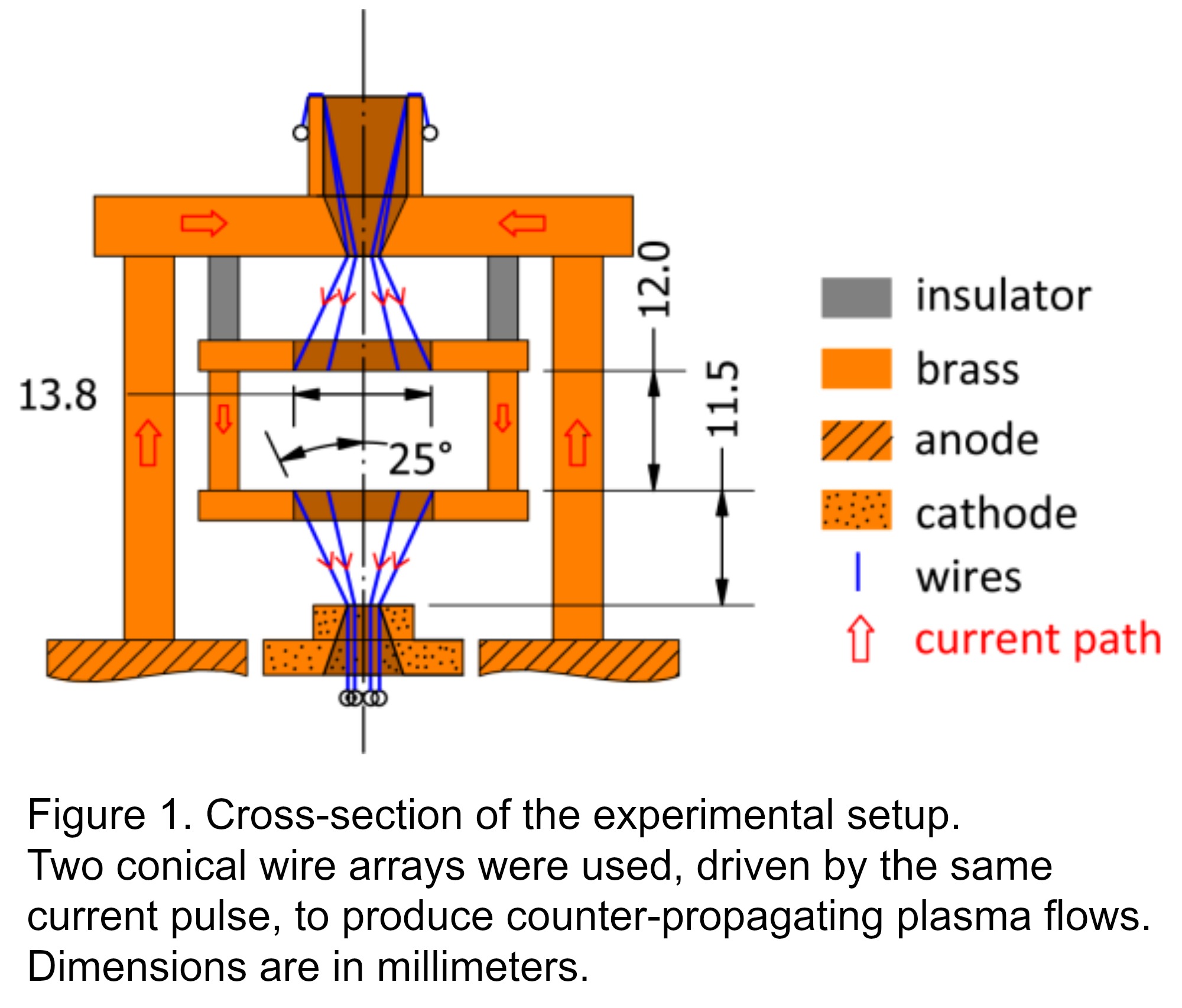 The Lorentz force produced by the interaction between the
self-generated global magnetic field and the current density
drives the coronal plasma towards the array axis, perpendicular
to the axis of each of the wires. As the plasma stagnates on
axis, it produces a standing conical shock that drives a plasma
jet away from the cone’s apex. In our setup, two plasma jets are
produced, propagating in opposite directions corresponding to
the orientation of the two arrays. We employed a few diagnostics
to examine the evolution of the jets, the primary of which was
a four-frame interferometry system with a 5 ns laser pulse at
532 nm and 15 ns inter-frame separation. We also implemented a
four-frame extreme ultraviolet (XUV) gated imaging camera.
The Lorentz force produced by the interaction between the
self-generated global magnetic field and the current density
drives the coronal plasma towards the array axis, perpendicular
to the axis of each of the wires. As the plasma stagnates on
axis, it produces a standing conical shock that drives a plasma
jet away from the cone’s apex. In our setup, two plasma jets are
produced, propagating in opposite directions corresponding to
the orientation of the two arrays. We employed a few diagnostics
to examine the evolution of the jets, the primary of which was
a four-frame interferometry system with a 5 ns laser pulse at
532 nm and 15 ns inter-frame separation. We also implemented a
four-frame extreme ultraviolet (XUV) gated imaging camera.
Figure 2a displays an unfolded interferogram of the
interaction of two aluminum jets at 323 ns into the current
profile. We observe that after collision, a shock is formed and
it slowly evolves into a bow-shock, remaining stationary for an
extended period of time, indicating pressure equilibration. We
have measured the jet speed to be >100 km/s and the sound speed
Cs ≈ 22 km/s, we find that the Mach number of the jets is
M ~ 5-10.It is theorized that radiative cooling effects are
responsible for different kinds of instabilities and
morphologies in jets and shocks4. In order to access this more
radiative regime, we used the same experimental set-up shown in
Fig. 1 but with Cu in the top array, a higher-Z metal. As the
atomic number of copper is larger than aluminum (roughly ×2),
radiative cooling due to bremsstrahlung effects should be
stronger than in the Al-Al case. For comparison we show some
experimental result in Fig. 2b). From these images we can see
that a bow shock also develops, however as the top jet
radiatively cools, the jet pressure decreases and the bow shock
becomes more collimated. The contact discontinuity between the
two materials is much sharper than in the case of Al-Al jets,
and as a result, it becomes unstable and fragments. At this
point, we also observe that the bow shock tip narrows and a
head-like structure develops.
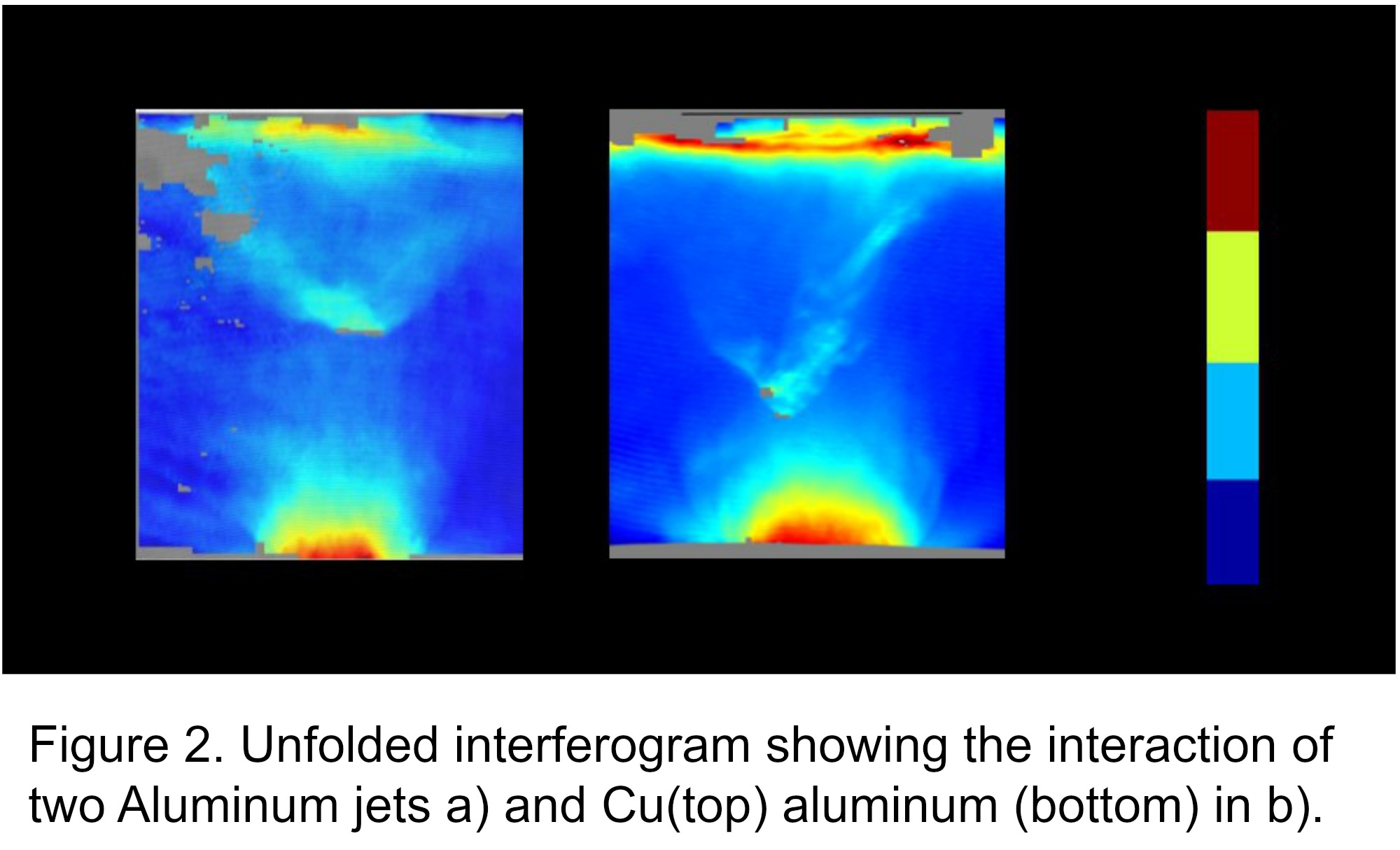
One can see qualitative similarities between this data and the Herbig-Haro objects in astrophysics, including the bow shock, the clumpy features and the leading nose cone.
Indeed, as both systems are described by the hydrodynamic/MHD equations, scaling criteria can be established between both systems, making it possible to reproduce the dynamics of astrophysical objects in the lab, but with much shorter time/spatial scales.